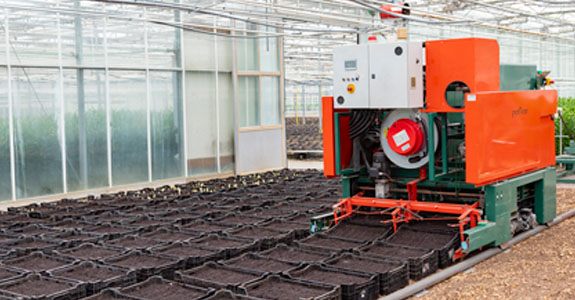Greenhouse tech today and tomorrow
Every day, you rely on technology to keep your greenhouse running smoothly—from ventilation and irrigation systems to boilers and heaters. And, just like your computer or your smartphone, operating systems keep upgrading and the technology required to keep your climate-controlled environment at optimum growing conditions also keeps advancing.
According to the 2021 Commercial Greenhouse Global Market Report, “Technological innovations such as artificial intelligence, automated irrigation systems, pH sensors, and climate control software are key trends gaining popularity in the commercial greenhouse market.”
Growers like you are focusing on modernizing their tools to help improve day-to-day efficiencies, optimize yields, and alleviate challenges in the labor market.
“Ten years ago, high tech wasn’t seen a lot in greenhouses,” notes Zach Bruce, Hortica safety services manager. “But today, automated transplanting systems, potting and pruning efficiencies, and robotic arms are common.”
Automation
Greenhouse technology involves using a variety of innovations to maximize crop production and improve business profitability. The adage, “work smarter, not harder,” certainly applies here. From managing the elements of your greenhouse operation to harvesting rainwater, the preciseness of automation can help enhance crop production and decrease costs.
Controls. Smart technology can help manage your operations. Wireless sensors throughout your greenhouse can measure temperature, humidity, CO2, and light so your grow room controller can automatically adjust the environment in real time. The sensor sends crop-level data to an operating system that controls motors to open or close based on certain triggers. You can monitor all the variables through an app on your mobile phone—which is where the term smart greenhouse comes from.
Irrigation. Self-sufficient rainwater systems aren’t new, but are improving. On average, a smart greenhouse can use nearly 98 percent less water than a greenhouse using traditional irrigation methods. For example, operations such as AppHarvest and Kentucky Fresh Harvest are high-tech, indoor farming operations that rely on automated rainwater harvesting systems to irrigate crops. These systems can reuse collected rainwater and internal condensation when and where it's most needed. This also recirculates fertilizer—another way greenhouses can potentially save money.
Robotics
Using a robot or robotic processes within your greenhouse is becoming more commonplace. If you've used a robotic vacuum cleaner or lawnmower at home, you've already experienced the benefits of robotics.
Here are a few examples currently used in some advanced commercial greenhouses:
Spacing robots can provide more consistent spacing and increase quality by optimizing plant placement and reducing the amount of water, pesticides, herbicides, and fertilizers used.
Pollinator robots can perform flower inspection, mapping, pollination, and development tracking.
Harvesting robots can accurately identify ripe versus unripe plants, harvest them, and place them in on-board boxing systems.
Vertical growing
Although going from horizontal to vertical growing may not sound technical, it actually introduces a myriad of technical efficiencies. Vertical growing can maximize space and double or triple the inventory within your greenhouse since you’re using nearly every square foot when you garden up-and-down, versus side-to-side, and use the power of gravity to enhance irrigation.
A vertical hydroponic system takes advantage of soilless gardening and recirculates water and nutrients. For more details, read our recent article on the benefits of the vertical growing shift.
Insuring your technology
If you anticipate your business investing in new technologies or updating your greenhouse management operation, ask your insurance provider for guidance, especially when it comes to protecting your investment. We offer crop insurance for plants grown in climate-controlled structures and have the experience and knowledge to assess risks horticultural businesses like yours face, including risks that could impact your greenhouse growing conditions.
If you have questions or would like to learn more about our full range of horticultural business insurance coverages or safety services, contact us.
Related links:
As your greenhouse, nursery, or garden center relies more on technology, its online vulnerabilities increase. Learn about common types of cybercrime and how you can help prevent them.
Concerned you may not have proper coverage? Learn more about insurance for greenhouse growers.
We’ll help you develop a workplace injury and accident prevention plan and identify risk exposures. Learn more about our safety and risk management services.
The information in this article is for informational or entertainment purposes only. View our disclaimer by going to terms and conditions and clicking on Learning Center disclaimer in the table of contents.

